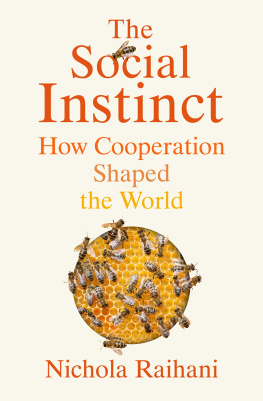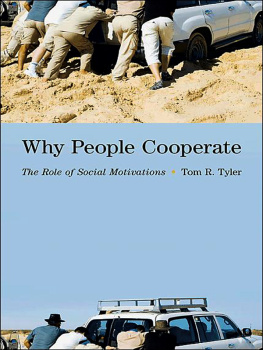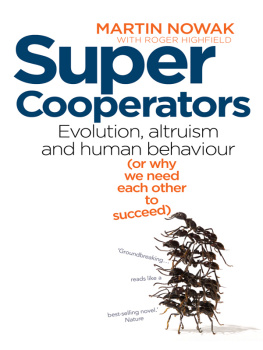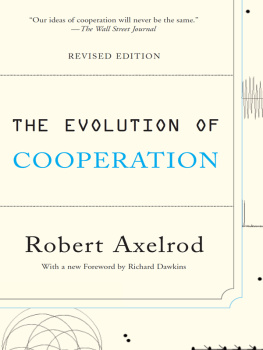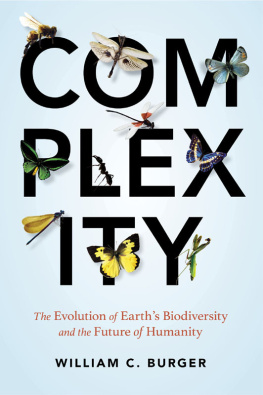
Nichola Raihani
THE SOCIAL INSTINCT
How Cooperation Shaped the World

Vintage
UK | USA | Canada | Ireland | Australia
New Zealand | India | South Africa
Vintage is part of the Penguin Random House group of companies whose addresses can be found at global.penguinrandomhouse.com.

First published by Jonathan Cape in 2021
Copyright Nichola Raihani 2021
The moral right of the author has been asserted
Jacket image Getty Images
ISBN: 978-1-473-57292-8
This ebook is copyright material and must not be copied, reproduced, transferred, distributed, leased, licensed or publicly performed or used in any way except as specifically permitted in writing by the publishers, as allowed under the terms and conditions under which it was purchased or as strictly permitted by applicable copyright law. Any unauthorized distribution or use of this text may be a direct infringement of the authors and publishers rights and those responsible may be liable in law accordingly.
CONTENTS
For my mum,
who was a victim of cooperation.
INTRODUCTION
I do not think that there is any evidence that man ever existed as a non-social animal.
Charles Darwin, 1871
As I type this, I sit at the kitchen table, practising the social distancing necessary to prevent the spread of a tiny pathogen that has blazed around the globe, changing our lives and routines in ways that seemed unimaginable just a few weeks ago. Workplaces have closed, cafes and restaurants are boarded up, and children are being schooled from home. Over the course of 2020, more than 64 million people would be infected, and 1.5 million killed. As convoys of army trucks lined the streets of small Italian towns to take the dead, and people were forced to say goodbye to their loved ones through phone screens, the rest of the world could only watch helplessly. This virus showed that we are vulnerable to forces of nature, including to things so tiny we cant even see them.
In some ways, the power of a tiny strand of genetic material is extraordinary: how did something that is 500 times smaller than the diameter of a hair destroy so much human life? The answer, of course, is that the viruss success was built on our own. By hunting and trading in wildlife, we enabled the novel coronavirus to jump from one species to the next. It crossed borders on our planes and boats. Like the pathogens of the past, this virus took advantage of the one thing that left humans uniquely exposed to a pandemic: our sociality.
Our social natures got us into this pandemic, but they are also our only way out of it. Although, as I write, it is not yet clear when we will emerge from this threat, we know how it will be done. To confront the virus, we must inhibit our most basic instincts that tell us to seek one another out in times of threat. We must accept constraints on what we can do, with whom and where. To confront the virus, scientists must strive towards a collective goal of finding a vaccine, while societys most essential workers provide the core services and commodities that we all need to survive. To confront the virus, political leaders need to consider not just their own constituents, but people living in other states and even in other countries. To confront the virus, we must cooperate.
Fortunately, this is something that we are extraordinarily good at.
This is a book about cooperation, the focus of my research since 2004. In a colloquial sense, the word cooperation has become synonymous with bland corporate metaphors, evoking images of firm handshakes and cheerful teamwork. But cooperation is much more than this: it is sewn into the fabric of our lives, from the most mundane of activities, like a morning commute, to our most tremendous achievements, such as sending rockets into space. Cooperation is our species superpower, the reason that humans managed not just to survive but to thrive in almost every habitat on Earth.
Less obviously, cooperation is also the reason we exist in the first place. At the molecular level, cooperation is ubiquitous: every living thing is composed of genes cooperating within genomes. Move up a rung of the ladder and you find the evolution of organisms, where multiple cells work together to make individuals. In most species, the cooperation stops there. Individuals, by and large, dont tend to help other individuals. However, there are a few outliers and they just so happen to be some of the most extraordinarily successful species on the planet. We are among them.
It is tempting to believe that our hyper-social nature marks us out as different, but the truth is that humans are just one of many species that live a social life. As a particularly poignant example of cooperation, take the Brazilian ant Forelius pusillus. By day, these ants forage above ground but, as evening falls, they retreat to the safety of their nest underground. Not all of them, though. A few ants remain outside, waiting for their sisters to scurry down the tiny tunnel. Then they get to work, dragging and carrying grains of sand and other debris to completely conceal the nest entrance from the outside. By sealing the nest, the workers seal their own fate, as solitary ants cannot survive overnight above ground. But dying near the nest could attract predators. In a final stoic gesture, the workers march into the desert night, dutiful protectors to the last.
Ant suicide is an extreme example, but cooperation is so often the key to understanding social behaviour, from the mundane to the awe-inspiring. Cooperation can tell us why parents care for their babies and why some offspring kill their mothers. It explains why pied flycatchers help their neighbours, whereas chimpanzees try to eliminate them. Cooperation sheds light on things we might never have thought to question before, such as the existence of menopause and sterile grandmothers, and why we are the only primate species that has them.
Of course, we cannot talk about cooperation without acknowledging the flip side: cooperation is infinitely vulnerable to cheats and freeloaders that exploit the collective for their own gain. As we shall see, often these social cheats are cooperating, but in ways that impose costs on others: cooperation frequently has victims. Cancer cells cooperate with one another inside multicellular bodies, to the detriment of the sufferers. Nepotism, corruption and bribery are all forms of cooperation, occurring among a minority of individuals while imposing wider costs to society.
Looking long and hard at precisely what humans and other animals do and do not have in common, through the lens of some of our most spectacular and mysterious collective behaviour, has been the mainstay of my academic career. Although I now mostly study humans, I followed a winding path round the globe to get here. Ive studied pied babbler birds in the Kalahari Desert, and Damaraland mole-rats in a broom cupboard in Pretoria; apostlebirds in the Australian outback, and cleaner fish living on tropical coral reefs. This may sound like a motley assortment, but these species have something important in common: they all cooperate. In babblers, apostlebirds and mole-rats, cooperation occurs primarily within families. Cleaner fish do things differently, by helping complete strangers fish they have never met and might never encounter again. And humans are especially interesting because we do both.
Next page
